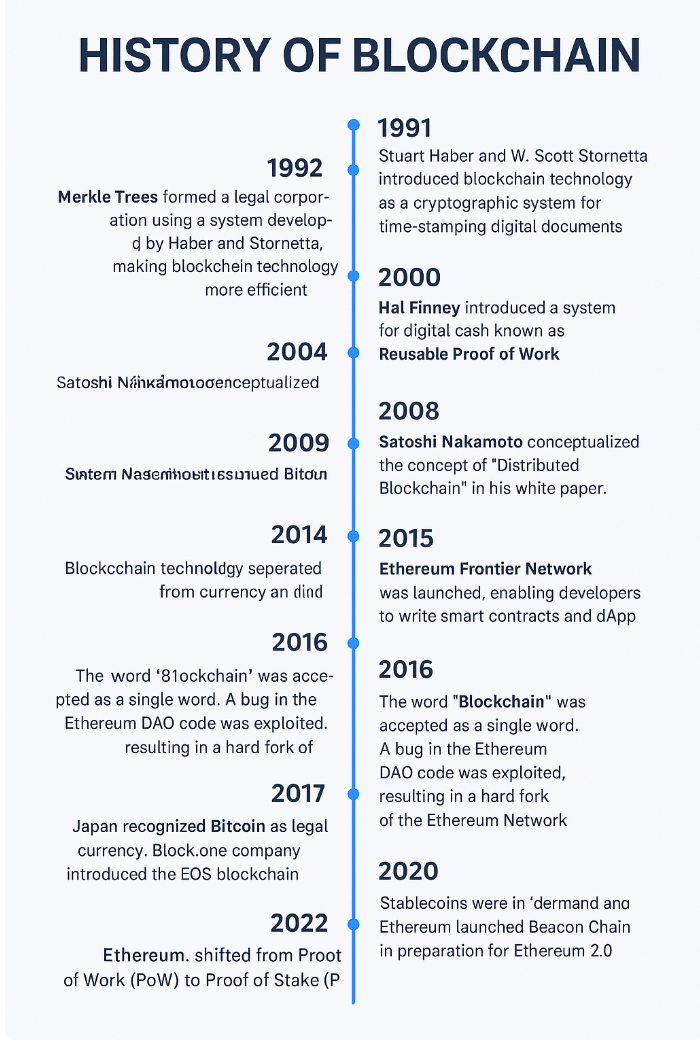History of Blockchain
This tutorial is on History of Blockchain

Blockchain, at its core, is a chain of blocks—a continuously growing ledger that records transactions in a secure, chronological, and immutable manner. Once a block is filled with data, it is permanently linked to the chain, and a new block is created to continue the process. Over the years, blockchain has transformed from a research idea into one of the most revolutionary technologies of our time. Let’s explore its evolution through the decades

1991 – The Beginning
The origins of blockchain trace back to 1991, when researchers Stuart Haber and W. Scott Stornetta introduced a cryptographic system for time-stamping digital documents. Their goal was to prevent tampering and backdating of files. By using cryptography, they developed a structure where documents were stored in a sequence of blocks, laying the foundation of blockchain technology.
1992 – Merkle Trees Enhance the System
In 1992, the concept was improved with the introduction of Merkle Trees, which allowed multiple documents to be collected within a single block. This made the system more efficient and scalable. Despite its innovation, the technology went largely unused for years.
2000 – New Cryptographic Concepts
By 2000, Stefan Konst expanded on the idea by publishing a theory on cryptographically secured chains and how they could be practically implemented. His work further clarified the possibilities of distributed ledgers.
2004 – Reusable Proof of Work
In 2004, Hal Finney, a cryptographic pioneer, developed Reusable Proof of Work (RPoW), a system designed to tackle the problem of double spending in digital currencies. This was a pivotal step toward digital money systems built on blockchain principles.
2008 – Nakamoto’s Breakthrough
The real turning point came in 2008, when the mysterious Satoshi Nakamoto released the white paper, “Bitcoin: A Peer-to-Peer Electronic Cash System.” Nakamoto built on earlier ideas and proposed a decentralized blockchain powered by proof-of-work, ensuring security, immutability, and trust without central authority.
2009 – Birth of Bitcoin
In 2009, Bitcoin was launched, marking the first real-world application of blockchain. The decentralized currency showed how blockchain could store and verify financial transactions. Bitcoin mining began this year, and stories like that of James Howells, who accidentally threw away a hard drive containing thousands of mined bitcoins, highlighted both the promise and the risks of this new digital asset.
2014 – Blockchain Expands Beyond Currency
By 2014, blockchain had evolved beyond cryptocurrencies. This era, often referred to as Blockchain 2.0, saw industries exploring blockchain for applications in finance, supply chains, and more.
2015 – Ethereum and Hyperledger
The launch of the Ethereum Frontier Network in 2015 was revolutionary—it enabled smart contracts and decentralized applications (dApps), greatly expanding blockchain’s capabilities. That same year, the Linux Foundation initiated the Hyperledger Project, aimed at developing enterprise-level blockchain solutions.
2016 – Challenges and Setbacks
In 2016, the term “Blockchain” was formally recognized as a single word. However, the year also brought challenges: a vulnerability in the Ethereum DAO led to a hard fork, splitting the Ethereum network, while the Bitfinex exchange hack resulted in the theft of 120,000 bitcoins.
2017 – Wider Adoption
Japan officially recognized Bitcoin as legal tender in 2017, a major milestone for global acceptance. Meanwhile, Block.one introduced EOS, a blockchain platform designed for scalable, commercial-grade decentralized applications.
2018 – A Decade of Bitcoin
Bitcoin celebrated its 10th anniversary in 2018, though its price saw a steep decline, falling to around $3,800. Concerns over scams and volatility led platforms like Google, Twitter, and Facebook to ban cryptocurrency advertisements.
2019 – Growth in Transactions and Services
In 2019, the Ethereum network reached over 1 million daily transactions, showing its popularity among developers and users. Around the same time, Amazon Web Services (AWS) launched the Amazon Managed Blockchain service, allowing businesses to build and scale blockchain networks easily.
2020 – Rise of Stablecoins & Ethereum 2.0
Stablecoins, pegged to traditional currencies, gained traction in 2020 due to their stability compared to volatile cryptocurrencies. Ethereum also launched the Beacon Chain, a crucial step toward the Ethereum 2.0 upgrade, which aimed to shift from proof-of-work to proof-of-stake.
2022 – Ethereum’s Energy-Efficient Transition
In 2022, Ethereum completed “The Merge”, transitioning from Proof of Work (PoW) to Proof of Stake (PoS). This reduced Ethereum’s energy consumption by approximately 99.95%, making it far more sustainable and marking a historic shift in blockchain technology.
From its humble beginnings in the 1990s as a cryptographic time-stamping method, blockchain has grown into a transformative technology powering cryptocurrency, smart contracts, enterprise applications, and beyond. Its journey—from research papers to global adoption—continues to shape the future of finance, governance, and digital innovation.
Test Your Knowledge
Practice what you've learned with these quizzes related to What is Blockchain?.
Continue Learning
Explore more topics in What is Blockchain? or browse other tutorials.